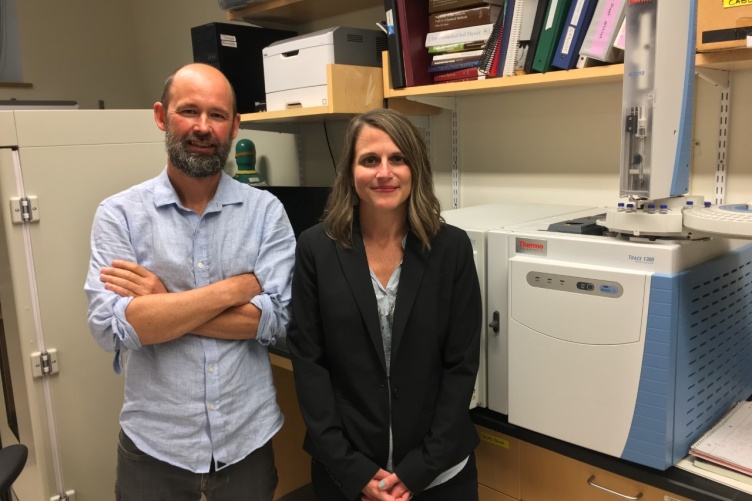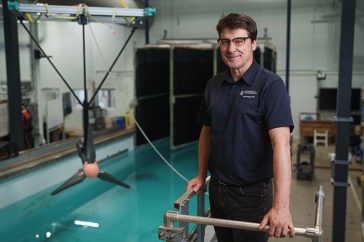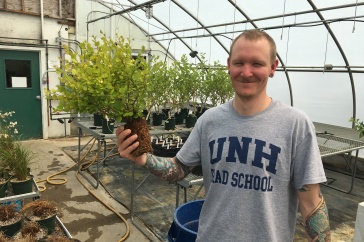
Stuart Grandy, professor of soil biogeochemistry and fertility, and Paula Mouser, associate professor of civil and environmental engineering, have received a two-year USDA equipment grant for $323,025 to purchase an ultra-high-performance high resolution liquid chromatography-tandem mass spectrometry instrument (UHPLC-MS/MS) similar to the instrument here. (This photo was taken prior to UNH's updated guidance, announced Sept. 9, 2021, requiring masks be worn in all indoor spaces.)
University of New Hampshire scientists have received three grants totaling $1 million that will support research addressing urgent questions in soil sustainability and, ultimately, resilient food production in New Hampshire and beyond. The projects range from using state-of-the-art instrumentation to determine components that help build soil organic matter, to increasing soil microbes' ability to increase the efficiency of nitrogen fertilizer, to understanding how plants extracts beneficial nutrients from soil organic matter.
The grants awarded to Stuart Grandy, professor of soil biogeochemistry and fertility, and colleagues were born from the results of recent research funded by the New Hampshire Agricultural Experiment Station in the UNH College of Life Sciences and Agriculture. This research investigated soil organic matter’s molecular makeup and affinity for minerals, and its potential to support plant growth in a reliable way that can moderate some of the stresses of climate change.
The work is taking in place, in part, at the experiment station’s Kingman Research Farm to help regional growers achieve better fertilizer nitrogen use efficiency. Another component of the research will support efforts to understand emerging contaminants associated with the application of biosolids to Granite State fields.
“With these new resources, we can keep pushing the envelope on critical questions in soil sustainability research by integrating observations on soil organic matter from multiple angles: molecular, microbial, mineral, and ecological,” Grandy said. “Understanding soil organic matter from these angles is the key to developing more nutrient efficient cropping systems that do not lose nitrogen and phosphorous to the environment. Soil organic matter also stores carbon, helping to reduce in the atmosphere the concentrations of the greenhouse gas carbon dioxide.”
Grandy, Paula Mouser, associate professor of civil and environmental engineering, and David Needle, senior pathologist with the UNH Veterinary Diagnostic Laboratory, have received a two-year USDA equipment grant for $323,025 to purchase an ultra-high-performance high resolution liquid chromatography-tandem mass spectrometry instrument (UHPLC-MS/MS).
This newly acquired high-precision instrument, which will be housed at the University Instrumentation Center Mass Spectrometry Core Facility, will allow scientists to conduct research at the molecular level. With it, scientists will be able to pinpoint which organic inputs contain components that endure in soil and contribute to building soil organic matter. This instrument will also be used by Paula Mouser and others to measure emerging organic contaminants in soil.
Measuring soil organic matter and the nutrients therein is the goal of a private grant supporting the work of Grandy and Serita Frey, professor of soil microbial ecology, to trace how agricultural fertilizers that can quickly drain out of soils might have more staying power through uptake by microbes, incorporation into soil organic matter, and subsequent associations with soil minerals. Such linkages between nutrients and soil minerals could provide plants—such as growing crops—a store of rations they can dip in to throughout the season. The $446,000 grant was awarded by the Ag Spectrum Company.
Finally, how exactly plants can make withdrawals of nutrients from soil organic matter is the subject of a new project between Grandy and Andrea Jilling, Grandy’s former student who is now an assistant professor of environmental soil chemistry at Oklahoma State University. The project is funded by a three-year grant for $260,000 from the National Science Foundation.
These new resources support Grandy’s immediate research group, the Soil Biogeochemistry and Fertility Lab, as well as the students and researchers with the UNH Center for Soil Biogeochemistry and Microbial Ecology, co-directed by Grandy, Jessica Ernakovich, assistant professor of natural resources and the environment, and Frey.
This material is based upon work supported by the NH Agricultural Experiment Station, through joint funding of the National Institute of Food and Agriculture, U.S. Department of Agriculture, and the state of New Hampshire.
Founded in 1887, the NH Agricultural Experiment Station at the UNH College of Life Sciences and Agriculture is UNH’s first research center and an elemental component of New Hampshire's land-grant university heritage and mission. We steward federal and state funding, including support from the USDA National Institute of Food and Agriculture, to provide unbiased and objective research concerning diverse aspects of sustainable agriculture and foods, aquaculture, forest management, and related wildlife, natural resources, and rural community topics. We maintain the Woodman and Kingman agronomy and horticultural research farms, the Macfarlane Research Greenhouses, the Fairchild Dairy Teaching and Research Center, and the Organic Dairy Research Farm. Additional properties also provide forage, forests, and woodlands in direct support to research, teaching, and outreach.
-
Written By:
Lori Tyler Gula, PhD | NH Agricultural Experiment Station | lori.gula@unh.edu | 603-862-1452



















































